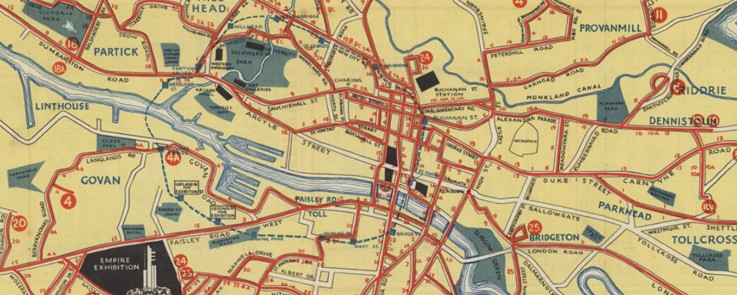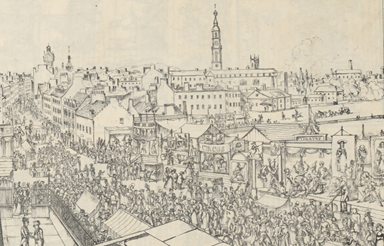Collated by Jamie McIntosh.
The final local authority area of our current Zoom Into series takes us to Glasgow, Scotland’s most populous city. Glasgow is situated in the west of the central belt area of the lowlands, and its city centre is dominated by the River Clyde. Glasgow’s position provides easy access to the greenery of the Loch Lomond and the Trossachs National Park to the north, and to the coast of the Firth of Clyde to the west. The city has long been one of the industrial heartlands of Scotland and underwent rapid expansion in the late 19th and early 20th centuries. Glasgow is the only city in Scotland to have an underground, the Subway, and in the mid 1960s Glasgow experienced further changes to transport with the building of the motorway, which saw major adaptations to the city centre layout. Glasgow is often affectionately referred to as the ‘dear green place’, and throughout the city there are over 90 parks and gardens for residents and visitors to enjoy. The largest of these parks, Pollok Country Park, is home to a herd of inquisitive highland cows. To top it all off, Glasgow can also boast some of the major cultural centres in Scotland, such as the Burrell Collection and the Royal Scottish National Orchestra, as well as an enviable music scene which has led to its status as a UNESCO city of music.
Where to find local collections:
The Mitchell Library
https://www.glasgowlife.org.uk/libraries/venues/the-mitchell-library
Online
http://www.mitchelllibrary.org/virtualmitchell/
Books – non fiction
McPhun’s guide through Glasgow, published at the London Newspaper Office, 1845. [In Antiquarian Books of Scotland.]
https://digital.nls.uk/120443483
Memoir of John Elder, engineer and shipbuilder, Glasgow, by W. J. Macquorn Rankine, 1883. [In Antiquarian Books of Scotland.]
https://digital.nls.uk/106682394
Books – fiction
Born into a God-fearing Free Church family in Glasgow, Catherine Carswell (1879-1946) grew up to be a free-spirited journalist and novelist whose works often attracted controversy.
Open the door, by Catherine Carswell, 1920. [In Works by selected Scottish authors.]
https://digital.nls.uk/128693589
Camomile: an invention, by Catherine Carswell, 1922. [In Works by selected Scottish authors.]
https://digital.nls.uk/128693593
You can read more about it in our Curator’s Choice blog post https://blog.nls.uk/?s=carswell
Film
KH-4, directed by Jon Schorstein, 1960s. [In Moving Image Archive.] A film about a Glasgow artist, played by a young Bill Forsyth, who uses the city as a source of inspiration. As he wanders the streets, the ongoing demolition process causes a disintegration of his ideas.
https://movingimage.nls.uk/film/3631
Manuscript collection
Transcripts and extracts from chartularies of the diocese of Glasgow, Registrum Episcopatus Glasguensis.
Transcripts by and for Lieutenant-General G H Hutton, 1813-1816, of two cartularies of the Diocese of Glasgow, 13th century-15th century. [In Online Manuscripts Catalogue.]
https://manuscripts.nls.uk/repositories/2/archival_objects/12922
Extracts made in 1556 from chartularies of the Archbishopric of Glasgow, covering the 12th to the 16th centuries. [In Online Manuscritps Catalogue.]
https://manuscripts.nls.uk/repositories/2/resources/19744
Registrum Episcopatus Glasguensis, edited by Cosmo Innes, 1843. [In Publications by Scottish Clubs – Bannatyne Club.]
https://digital.nls.uk/81612841
Maps
[Glasgow and the county of Lanark] – Pont 34, Timoth Pont, c.1583-96. [In Maps of Scotland.]
https://maps.nls.uk/view/142842734
Glasgow Corporation Transport map of bus routes, Glasgow Corporation Transport, 1938. [In Town Plans/Views, 1580s-1940s.]
https://maps.nls.uk/view/142842734
An e-resource
SCRAN – In Your Area: Glasgow. [In e-resources.] Available online to Scottish residents registered with the National Library of Scotland.
https://www.scran.ac.uk/hierarchy/yourlocalarea/2/4557/Glasgow
A business
Glasgow Looking Glass. [In Wee Windaes.] The Glasgow Looking Glass was a satirical broadsheet, and has been described as the world’s first comic. The first issue was published on the 11th of June, 1825, with new issues appearing fortnightly. The publication only ran for 5 issues before becoming the Northern Looking Glass.
https://wee-windaes.nls.uk/glasgow-looking-glass/
A person
Dame Jean Roberts, born in Springburn in 1895, started her career as a primary teacher before standing as a labour councillor, and was eventually elected as the first female Lord Provost of Glasgow in 1960.
Panda Crossings, c.1961. [In Moving Image Archive.]
https://movingimage.nls.uk/film/5136
A song or piece of music
The St Columba Gaelic Church has long been an important centre for Gaelic worship and community in Glasgow. The church established a Gaelic choir in 1872, which was fundamental in the founding of An Comunn Gàidhealach in 1891 in Oban. Out of this the Royal National Mòd (Am Mòd Nàiseanta Rìoghail) came into being, providing a platform to promote Gaelic language, music, and culture. The Mòd has been held in Glasgow 13 times since its foundation, and several of the programmes can be seen on our website.
Programme of the 45th Annual Mòd, 1948. [In An Comunn Gàidhealach.]
https://digital.nls.uk/187548502
Programme of the 85th Annual Mòd, 1988. [In An Comunn Gàidhealach.]
https://digital.nls.uk/125660246
A castle or other historic building
Glasgow Blind Asylum, established in the early 19th century. The building on Castle Street was later replaced by a new building featuring a hexagonal clock tower, designed by William Landless. The Blind Asylum printed many works of fiction and non-fiction for the use of the blind, some of which are found in our collections.
Selection of fables, with wood cuts, for the use of the blind, Glasgow Asylum for the Blind, 1838. [In Rise of Literacy.]
https://digital.nls.uk/188009005
Food
Biscuit making in 1928, filmed by Jack MacFarlane, 1928. [In Moving Image Archive.] Film showing the production of Macfarlane Lang’s rich tea and cream cracker biscuits at the company’s Tollcross factory, Glasgow.
https://movingimage.nls.uk/film/0535
Making Sweets, Educational Films of Scotland, 1952. [In Moving Image Archive.] Filmed at Birrell Confectioners, Glasgow showing the different stages involved in the manufacturing of sweets.
https://movingimage.nls.uk/film/1752
A photograph
Photographs of Glasgow taken by Thomas Annan in the 1860s. [In Thomas Annan’s Glasgow].
https://digital.nls.uk/learning/thomas-annan-glasgow/index.html
The photographs featured on this site provide a unique glimpse of the burgeoning Victorian city with streets and tenements now all long disappeared. They provide a fascinating visual document that traces the social history of one of Scotland’s most prosperous and ever-changing cities.
Something about a village or small place
Possilpark is an area found to the north of the city centre. Today, the district is regarded is one of the most deprived areas in Glasgow following changes brought by post-industrialisation. It is currently home to diverse community organisations working for social regeneration, but the area also played an important role in the industrial expansion of Glasgow city in the late 19th and early 20th centuries. Possil House, built c.1808, dominated the estate lands before it was demolished in the late 19th century to make way for the Saracen Foundry works and housing for the workers. The Saracen Foundry was owned by Walter MacFarlane and Co., and the company produced many of the elaborate water fountain castings which were found throughout Glasgow. In 1911 the construction began on Possilpark District Library, the last of the pre-First World War libraries built in the city. Construction was finished in 1913, with interior murals painted by students from the Glasgow School of Art, which can still be seen today. Nearby is Possil Marsh, a site of special scientific interest for flora and fauna, and where there is also a monument to the High Possil meteorite which landed there in 1804.
The rapid industrial expansion around Possilpark is best viewed in a series of maps:
Map of the town of Glasgow & country seven miles around, Thomas Richardson, 1795. [In Maps of Scotland.] Shown here as ‘High Possil’
https://maps.nls.uk/counties/rec/645
Map shewing…estate of Milton, Thomas Kyle 1842. [In Town Plans / Views, 1580s-1940s.] Shown here as ‘Lands and Estate of Possil’
https://maps.nls.uk/towns/rec/440
New plan map of Glasgow, with suburbs, from ordnance and actual surveys. Constructed for the Post office Directory, John Bartholomew, 1922. [In Town Plans / Views, 1580s-1940s.]
https://maps.nls.uk/towns/rec/6120
Ordnance Survey Map NS56NE – A, 1956. [In National Grid Maps, 1944-1970.]
https://maps.nls.uk/view/188144097
The issues of post-industrial regeneration in Possilpark are also explored in the following film:
Places… or people, Films of Scotland and the City of Glasgow District Council (Department of Environmental Improvement), 1975. [In Moving Image Archive.]
https://movingimage.nls.uk/film/3148
Further reading
Possil Marsh – Yesterday and today, or, Jottings from my journals. With map., by William Rennie, 1951.
https://search.nls.uk/permalink/f/sbbkgr/44NLS_ALMA21542488720004341
Glasgow, the friendly city. An interview with Lord Provost Dame Jean Roberts, J.P. (Reprinted … [from] Glasgow “Evening Citizen”.), by Julie Promise, [1962].
https://search.nls.uk/permalink/f/19q5vbt/44NLS_ALMA21453899630004341
A tale of two towns: a history of medieval Glasgow, by Neil Baxter, 2008.
https://search.nls.uk/permalink/f/1jc5lod/44NLS_ALMA21504547680004341

